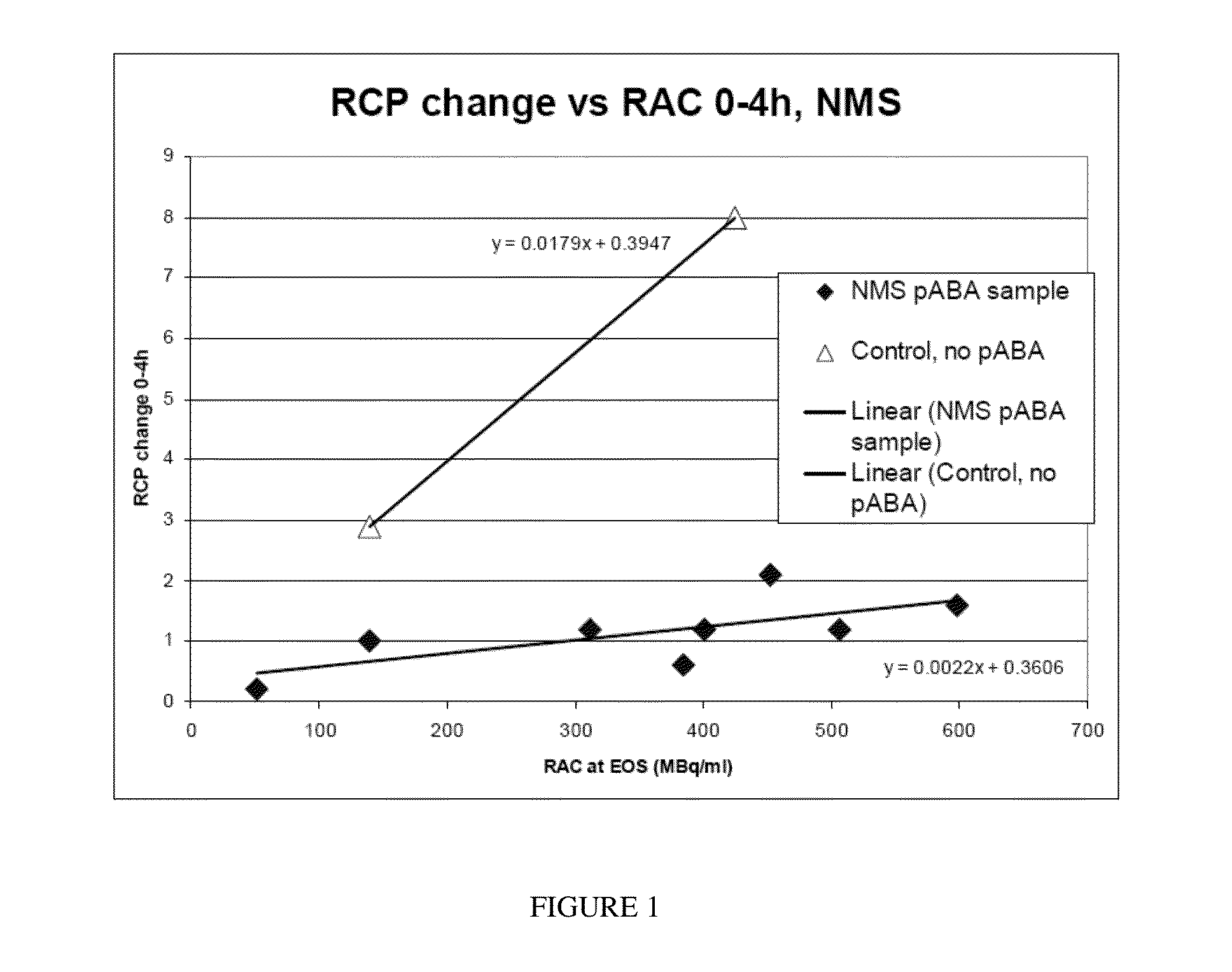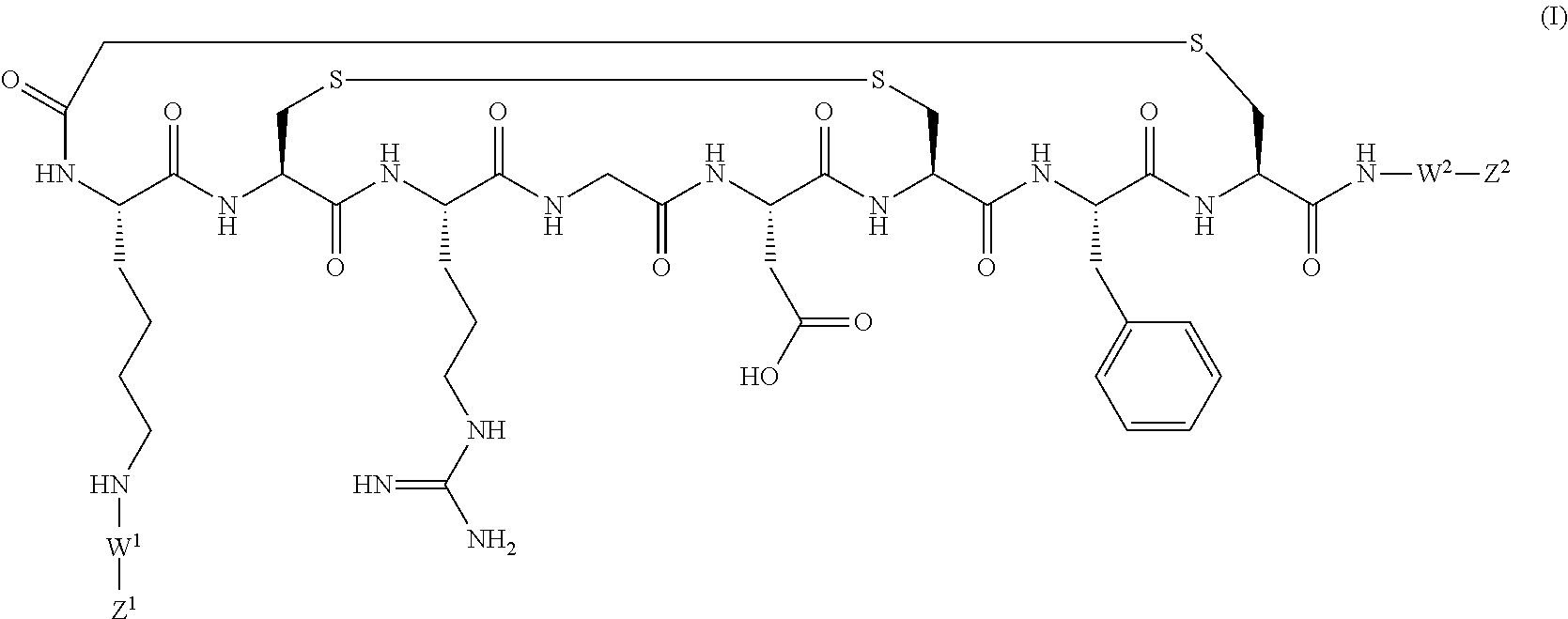Radiotracer compositions
a radiotracer and composition technology, applied in the field of radiotracer compositions, can solve the problems of limited patient doses available from a given radioactive synthesis, previously unrecognised, and limit the shelf-life of usable clinical imaging post-synthesis
- Summary
- Abstract
- Description
- Claims
- Application Information
AI Technical Summary
Benefits of technology
Problems solved by technology
Method used
Image
Examples
example 1
Synthesis of Precursor 1
[0122]Peptide 1 was synthesised using standard peptide synthesis, as described by Indrevoll et al [Bioorg. Med. Chem. Lett., 16, 6190-6193 (2006)].
(a) 1,17-Diazido-3,6,9,12,15-pentaoxaheptadecane
[0123]A solution of dry hexaethylene glycol (25 g, 88 mmol) and methanesulfonyl chloride (22.3 g, 195 mmol) in dry THF (125 mL) was kept under argon and cooled to 0° C. in an ice / water bath. A solution of triethylamine (19.7 g, 195 mmol) in dry THF (25 mL) was added dropwise over 45 min. After 1 hr the cooling bath was removed and the reaction was stirred for another for 4 hrs. Water (55 mL) was then added to the mixture, followed by sodium hydrogencarbonate (5.3 g, to pH 8) and sodium azide (12.7 g, 195 mmol). THF was removed by distillation and the aqueous solution was refluxed for 24 h (two layers were formed). The mixture was cooled, ether (100 mL) was added and the aqueous phase was saturated with sodium chloride. The phases were separated and the aqueous phase w...
example 2
Radiosynthesis of [18F]-Fluorobenzaldehyde (18F-FBA)
[0130][18F]-fluoride was produced using a GEMS PETtrace cyclotron with a silver target via the [18O](p,n) [18F] nuclear reaction. Total target volumes of 1.5-3.5 mL were used. The radiofluoride was trapped on a Waters QMA cartridge (pre-conditioned with carbonate), and the fluoride is eluted with a solution of Kryptofix2.2.2 (4 mg, 10.7 μM) and potassium carbonate (0.56 mg, 4.1 μM) in water (80 μL) and acetonitrile (320 μL). Nitrogen was used to drive the solution off the QMA cartridge to the reaction vessel. The [18F]-fluoride was dried for 9 minutes at 120° C. under a steady stream of nitrogen and vacuum. Trimethylammonium benzaldehyde triflate, [Haka et al, J. Lab. Comp. Radiopharm., 27, 823-833 (1989)] (3.3 mg, 10.5 μM), in DMSO (1.1 mL) was added to the dried [18F]-fluoride, and the mixture heated at 105° C. for 7 minutes to produce 4[18F]-fluorobenzaldehyde.
example 3
Purification of [18F]-Fluorobenzaldehyde (18F-FBA)
[0131]The crude labelling mixture from Example 2 was diluted with ammonium hydroxide solution and loaded onto an MCX+SPE cartridge (pre-conditioned with water as part of the FASTlab sequence). The cartridge was washed with water, dried with nitrogen gas before elution of 4-[18F]-fluorobenzaldehyde back to the reaction vessel in ethanol (1.8 mL). A total volume of ethanol of 2.2 mL was used for the elution but the initial portion (0.4 mL) was discarded as this did not contain [18F]-FBA. 4-7% (decay corrected) of the [18F] radioactivity remained trapped on the cartridge.
PUM
| Property | Measurement | Unit |
|---|---|---|
| pH | aaaaa | aaaaa |
| pH | aaaaa | aaaaa |
| concentration | aaaaa | aaaaa |
Abstract
Description
Claims
Application Information
 Login to View More
Login to View More - R&D
- Intellectual Property
- Life Sciences
- Materials
- Tech Scout
- Unparalleled Data Quality
- Higher Quality Content
- 60% Fewer Hallucinations
Browse by: Latest US Patents, China's latest patents, Technical Efficacy Thesaurus, Application Domain, Technology Topic, Popular Technical Reports.
© 2025 PatSnap. All rights reserved.Legal|Privacy policy|Modern Slavery Act Transparency Statement|Sitemap|About US| Contact US: help@patsnap.com



